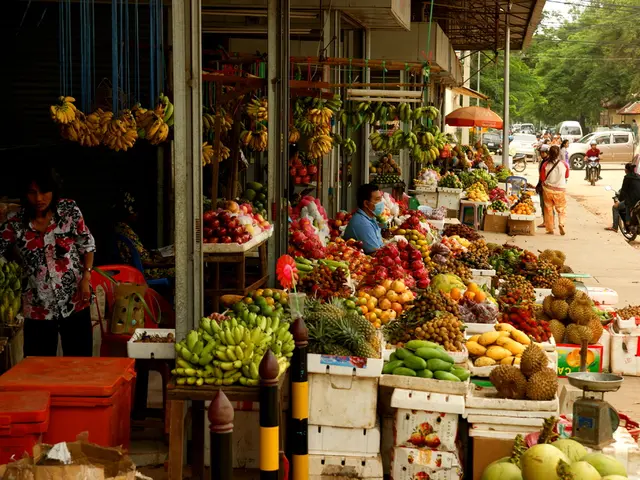Trees with Stunning Fall Leaves of Vivid Autumn Hues
Autumn's magic hits different when you witness a landscaping transformation into a kaleidoscope of reds, oranges, and yellows. Such is the enchantment of fall trees, each bursting with dazzling colors that captivate and add charm to any garden or backyard.
Fancy creating some seasonal eye-candy? Then take a peek at our top 9 fall trees that exhibit vibrant autumn leaves, flaunting a burst of beauty and excitement perfect for your outdoor space. These not only charm during the fall season but also offer benefits such as providing shade, privacy, and year-round visual appeal!
Excuse us for the flattery — after all, we're all about spreading positive vibes!
9 Fall Trees with the Most Vibrant Autumn Leaves
1. Sourwood
A tiny, adorable tree, the Sourwood, or Oxydendrum arboreum, steals the show with its unique charm. It derives its name from the tart taste of its leaves, which are 4 to 7 inches long, elliptical, and finely toothed. This sweetie-pie springs to life in early to mid-summer with small, fragrant white flowers that look like lily of the valley clustered together, creating a delightful spectacle.
As autumn whispers 'soon,' the Sourwood becomes the star of the show with its brilliant fall colors, ranging from red, scarlet, and deep red wine shades. Although it stays small, at 30 to 40 feet in height and 8 to 12 inches in diameter, its impact won't be diminished in your garden. Did we mention that it also contributes to honey production? Honeybees can't resist its flowers, and the nectar they gather makes top-quality honey that's the envy of every beekeeper!
2. River Birch
Hailing from the eastern United States is the unique and beautiful River Birch tree, or Betula nigra. Its distincitive diamond-shaped leaves can grow glossy medium green on the top, while displaying a paler, silvery shade underneath in the springtime. But wait for the autumn, when the leaves turn a bright golden yellow, although they often tend to become a dull brownish-yellow hue before dropping off in late autumn or early winter.
Striking yet subtle, the River Birch is a favorite for its textured red, pink, and brown peeling bark — a feature that leaves you mesmerized throughout the year. This tree stands tall, typically reaching between 40 to 70 feet, with a spread of 40 to 60 feet. Thanks to its quick growth rate and ability to thrive in wet soil conditions, it's a valued addition to any landscape — and a bonus, it supports local wildlife like birds and butterflies!
3. Quaking Aspen
A tree that deserves recognition for its distinctive features is the quaking aspen, named for its trembling leaves that quiver when the wind blows. As summer gives way to autumn, this mesmerizing dance continues, thanks to the petioles that attach its leaves to the branches, causing them to 'quake' in even the gentlest breeze.
Growing up to 40 to 50 feet in height, the quaking aspen grows rapidly and presents a delightful sight with its wide, spreading canopy blocking sunlight while adding visual interest to your landscape. If you've found the perfect spot for this lovely tree, it'll serve as a shade tree just as beautifully as an ornamental tree.
4. Shumard Oak
When searching for a hardy, magnificent tree that provides impressive size, shade, and ornamental appeal, the Shumard red oak stands out as a top choice. Not only is it adored for its striking form, but it's also celebrated for its resilience in urban environments, where it thrives despite the challenges posed by city life.
With a tall, straight trunk and sturdy branches that extend upwards, the Shumard red oak takes on a stately air as its leaves transform into a stunning display of fiery scarlet, deep burgundy, or even rusty red in the autumn season. As the leaves drop, the tree's grand structure remains visible, adding an attractive focal point to your garden throughout the winter months.
5. Ginkgo
If you're serious about making a statement, the Ginkgo tree (or Ginkgo biloba) is your huckleberry! Renowned for its beauty, uniqueness, and remarkable longevity, this tree can trace its origins back nearly 200 million years. Its fan-shaped leaves turn a brilliant yellow in the fall—all 5 lobed, 2 to 3 feet long, and sporting lovely, deep green hues—before they shed, leaving behind a bed of golden leaves.
At maturity, the Ginkgo tree reaches outstanding heights of 80 feet, with a spread of around 40 feet. What's even more impressive is that it thrives in heat, pollution, and a wide range of soil types, making it a hardy and versatile choice for any landscape.
6. Black Tupelo
Discover a true gem of a native tree with the Black Tupelo (or Nyssa sylvatica), known for its striking foliage: leaves presents in shades of green that transform into a stunning array of yellow, orange, bright red, and purple hues come autumn. The wonder doesn't end here, as the Black Tupelo's bark resembles that of an alligator, adding texture and visual interest to your landscape throughout the year.
In the early summer, this tree produces modest flowers that offer sustenance to pollinators, while also managing to maintain an air of modesty. The Black Tupelo is hardy in zones 4 to 9, rewarding you with a delightful autumn show in the right environmental conditions: full sun or partial shade. This adaptable tree flourishes in well-drained soil, acidic or moist.
7. American Beech
Looking for a towering, grand tree with beautifully smooth bark and stunning golden falls? The American Beech, or Fagus grandifolia, is the tree you've been searching for! At maturity, the American Beech typically reaches between 50 and 80 feet, with its spread reaching 20 to 30 feet. One of its most distinctive features is its unblemished light gray bark, which remains silky for years on end — an unparalleled characteristic compared to other trees.
The American Beech is a treat for the eyes, thanks to its dark green, glossy leaves that turn a beautiful copper hue during the autumn season. Don't forget about the scent, either! The sunlight filtering through its branches brings a delightful scent to your senses. Best of all, this tree offers a valuable food source for wildlife, as the beechnuts it produces serve as a crucial food source for various birds, squirrels, and deer.
8. Sugar Maple
Circle the wagons, folks, because the Sugar Maple, or Acer saccharum, is a heavyweight contender when it comes to vibrant autumn colors. You can't miss its iconic leaves, which are palmate with 5 lobes and feature prominent veins. Sugar Maples take on a brilliant red, orange, or a brilliant combination of various shades as they fall.
Typically reaching heights of 60 to 80 feet, the Sugar Maple is a marvel of nature, providing ample shade with its broad, rounded canopy. Springtime brings delicate, inconspicuous green flowers, and you'll find yourself tempted to taste the sweet sap that drips from its branches!
9. Red Maple
We reckon the Red Maple, or Acer rubrum, deserves a big round of applause for its versatility and adaptability. This tree's claim to fame is its vibrant red hues during every season: red flowers and fruit, red twigs, and brilliant red, orange, and yellow leaves in the fall. However, it's not uncommon for Red Maples to transform into a variety of other dazzling shades as well.
The Red Maple can grow up to 90 feet in height, making it a popular choice for both urban and countryside landscapes. It grows best in full sun (at least 6 hours daily) but can also tolerate partial shade. While it prefers rich, well-drained soil, it's nevertheless quite adaptable, even thriving in swamp and bog conditions.
In conclusion, adding vibrant fall trees to your landscape is a fantastic way to elevate your outdoor space and welcome the incoming season with a fiery embrace. From diminutive trees like the Sourwood with deep red-purple foliage to larger, eye-catching trees like the Sugar Maple and Red Maple, there's a beautiful array to choose from. Just remember to pick the perfect spot for your tree (full sun is best!) and provide it with well-drained soil, fertilizer, and tender loving care. With a little patience and a generous dash of love, your garden will come alive in a palette of warm autumn colors! 🔥😄
- The Sourwood tree, with its spectacular fall foliage that ranges from red, scarlet, and deep red wine shades, not only adds a burst of beauty and excitement to any garden but also contributes to honey production, making it a perfect choice for both visual appeal and serving as a source of food for bees.
- The River Birch tree, particularly in the autumn, shows off its bright golden yellow leaves, and its distinctive red, pink, and brown bark remains a visual delight throughout the year, making it an attractive addition to any landscape and a favorite for wildlife like birds and butterflies.
- The Red Maple tree's vibrant red, orange, and yellow leaves in the fall make it a top choice for those looking to create a stunning outdoor space, offering versatility and adaptability, growing well in a variety of soil conditions and lighting, making it a popular choice for both urban and countryside landscapes.




